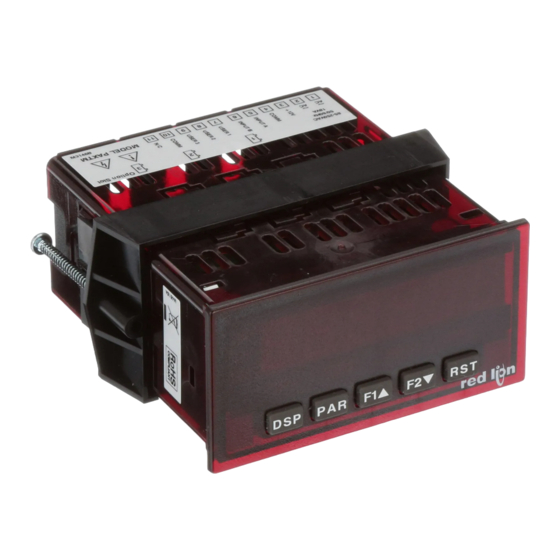Table of Contents
Advertisement
Quick Links
Tel +1 (717) 767-6511
Fax +1 (717) 764-0839
www.redlion.net
MODEL PAX-1/8 DIN PRESET TIMER (PAXTM) &
U
L
C
US LISTED
US LISTED
4
IND. CONT . EQ.
51EB
GENERAL DESCRIPTION
®
The PAXTM (PAX
Timer) and PAXCK (PAX
features and performance capabilities to suit a wide range of industrial
applications. Both can function as an Elapsed Timer or Preset Timer, while the
PAXCK also offers Real-Time Clock with Date capability. The Plug-in option
cards allow the opportunity to configure the meter for the present application,
while providing easy upgrades for future needs.
Both units can function as an Elapsed Time Indicator. By using two separate
signal inputs and 23 selectable timer ranges, the meters can be programmed to
meet most any timing application. With the addition of a Plug-in Setpoint card,
they can easily become a dual or quad output preset timer.
The PAXCK can also operate as a Real-Time Clock (RTC), with the Real-
Time Clock Card already installed. The meter is capable of displaying time in
12 or 24-hour time formats. The 12-hour format can be displayed in hours and
minutes, with or without an AM/PM indication or in hours, minutes, and
seconds. The 24-hour format can be displayed in hours and minutes or in hours,
minutes, and seconds. The PAXCK is also capable of a calendar display in
which the day, month and/or year can be displayed. The meter will recognize
leap years, and can automatically adjust for Daylight Savings Time. The Real-
Time Clock has the ability to externally synchronize with other PAXCK meters
to provide a uniform display network throughout the plant.
If the application calls for both a Preset Timer and a Real-Time Clock at the
same time, the PAXCK can handle this requirement as well. The meter provides
up to four different displays, accessed via front panel push buttons or external
inputs. The displays are Timer (TMR), which displays the current timer value;
Count (CNT), which displays the current cycle counter value; Date (DAT),
which displays the current programmed date; and Real-Time Clock, which
displays the current time. A battery-backed Real-Time Clock plug-in card is
provided with the PAXCK. This card, which includes a lithium coin-cell battery,
will maintain the time and date when main power is removed.
The meters accept inputs from a variety of sources including switch contacts
and outputs from CMOS or TTL circuits. The input can be configured to trigger
on the edge or level of the incoming pulse. Internal jumpers are available to allow
the selection for sinking inputs (active low) or sourcing inputs (active high).
The front panel keys and three user inputs are programmable to perform
various meter functions. One of the functions includes exchanging parameter
lists, allowing for two separate listings of setpoint values, timer start/stop
values, counter start/stop values and RTC daily on and off values.
DIMENSIONS In inches (mm)
REAL-TIME CLOCK (PAXCK)
®
Clock/Timer) offer many
Note: Recommended minimum clearance (behind the panel) for mounting
clip installation is 2.1" (53.4) H x 5" (127) W.
1
6-DIGIT 0.56" RED SUNLIGHT READABLE DISPLAY
4 SEPARATE DISPLAYS (Timer, Counter, Real-Time Clock, and Date)
CYCLE COUNTING CAPABILITY
PROGRAMMABLE FUNCTION KEYS/USER INPUTS
FOUR SETPOINT ALARM OUTPUTS (W/Plug-in card)
COMMUNICATIONS AND BUS CAPABILITIES (W/Plug-in card)
BUS CAPABILITIES: DEVICENET, MODBUS and PROFIBUS-DP
®
CRIMSON
PROGRAMMING SOFTWARE
NEMA 4X/IP65 SEALED FRONT BEZEL
The meters can have up to four setpoint outputs, determined by the optional
plug-in cards. The setpoint plug-in cards provide dual FORM-C relays (5A),
quad FORM-A relays (3A) or either quad sinking or quad sourcing open
collector logic outputs. The outputs can be assigned to the timer, counter, RTC
date, and RTC time. The outputs can also be independently configured to suit a
variety of control and alarm requirements.
Plug-in cards can also provide serial communications. These include RS232,
RS485, Modbus, DeviceNet, and Profibus-DP. Display values, setpoint alarm
values and setpoint states can be controlled through serial communications.
With the RS232 or RS485 communication card installed, it is possible to
configure the meter using a Windows
data can be saved to a file for later recall.
Once the meters have been initially configured, the parameter list may be
locked out from further modification entirely, or the setpoint, timer start/stop
values, counter start/stop values, RTC time SET, and Display Intensity can be
made accessible. This lockout is possible through a security code or user input.
The meters have been specifically designed for harsh industrial environments.
With a NEMA 4X/IP65 sealed bezel and extensive testing to meet CE
requirements, the meter provides a tough yet reliable application solution.
SAFETY SUMMARY
All safety related regulations, local codes and instructions that appear in this
literature or on equipment must be observed to ensure personal safety and to
prevent damage to either the instrument or equipment connected to it. If
equipment is used in a manner not specified by the manufacturer, the protection
provided by the equipment may be impaired.
Do not use this unit to directly command motors, valves, or other actuators
not equipped with safeguards. To do so can be potentially harmful to persons or
equipment in the event of a fault to the unit.
CAUTION: Risk of Danger.
Read complete instructions prior to
installation and operation of the unit.
Bulletin No. PAXCK-G
Drawing No. LP0524
Released 2/08
®
based program. The meter configuration
CAUTION: Risk of electric shock.
Advertisement
Table of Contents
















Need help?
Do you have a question about the PAXCK and is the answer not in the manual?
Questions and answers